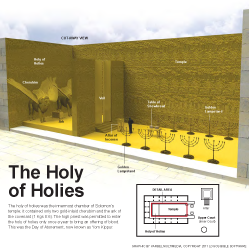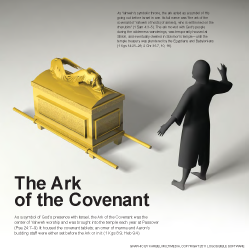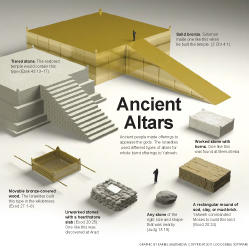6:1–38 The description of Solomon’s temple The building of this temple marked a new era and required divine sanction (2 Sam 7:13; 1 Kgs 5:3–5; 6:12–13), preparation (5:6–18), execution (chs. 6–7), dedication of the building (ch. 8), and blessing for the builder and his offspring (9:1–5). All of these elements appear in the account of Solomon’s temple. |
6:1 four hundred and eightieth year This number is based on the calculation of 12 generations of 40 years. The ancient Greek translation of the ot, the Septuagint, reads 440 years, perhaps counting only 11 generations of priests from Aaron to Zadok (1 Chr 6:1–12).
fourth year of Solomon’s rule over Israel The narrative may have been taken from a royal archive (1 Kgs 14:29) or the book of the acts (or annals) of Solomon (11:41).
the month of Ziv The second month in the Phoenician calendar (April—May); one of several Phoenician month names to appear in this narrative (see vv. 37–38; 8:2). The concentration of Phoenician month names in chs. 6–8 and their absence in the rest of the ot suggest that this building report comes from a document that was contemporary to the temple building.
(April—May); one of several Phoenician month names to appear in this narrative (see vv. 37–38; 8:2). The concentration of Phoenician month names in chs. 6–8 and their absence in the rest of the ot suggest that this building report comes from a document that was contemporary to the temple building.
 Israelite Calendar Table
Israelite Calendar Table
 Calendars in Old Testament Times
Calendars in Old Testament Times
house for Yahweh The Hebrew phrase used here, beth yhwh, a frequent title for the temple, reflects the ancient Near Eastern belief that deities resided in houses built for their names. It is unclear whether the ancients believed their gods literally dwelt in temples or whether they thought of idols and other physical representations as depictions of the deity.
 The Name Theology of the Old Testament
The Name Theology of the Old Testament
6:2 sixty cubits in its length A cubit is approximately 18 inches long. The temple was 90 feet long, 30 feet wide, and 45 feet high.
is approximately 18 inches long. The temple was 90 feet long, 30 feet wide, and 45 feet high.
6:3 vestibule The Hebrew word used here, ulam, describes a porch or entrance hall. Compare 7:6–8.
the main hall of the temple The Hebrew phrase used here is hekhal habbayith. The word hekhal refers to the sanctuary, whereas habbayith refers to the house. This is the main hall between the ulam (vestibule) and the devir (inner chamber or most holy place, also called the holy of holies).
6:4 specially designed framed The precise meaning of the Hebrew phrase shequfim atumim is unknown; it may describe latticed windows.
6:5 all along the walls of the house May describe a stepped platform on which to build the side chambers (v. 6).
the inner sanctuary This is the inner chamber of the temple where Yahweh resided. Only the high priest could enter it, and only once a year—on the Day of Atonement. See note on Lev 16:1–34.
side rooms The Hebrew term used here, tsela'oth, comes from the word tsela’, which was used to describe Adam’s “rib” in Gen 2:21.
“rib” in Gen 2:21.
6:6 cubits See note on 1 Kgs 6:2.
6:7 with stones finished at the quarry Servants of Solomon, Hiram, and the Gebalites prepared these stones (5:15–18).
6:8 the side of the temple was on the south The word yamin means “right” or “south.”
a stairway The Hebrew word used here, lul, may describe a winding staircase. It may be related to the term lula’ot, the loops that held up the fabric of the tabernacle (Exod 26:4).
(Exod 26:4).
6:9 finished it The Hebrew term used here, yekhallehu, comes from the word khalah, which is used to describe the completion of creation (Gen 1–2:4; 1 Kgs 6:14).
cedars See 5:6 and note, 5:8 and note.
6:12 which I made to David your father Echoes the Davidic covenant (2 Sam 7:8–16). First Kings 6:12 understands the covenant as conditional, but the record of the covenant does not include any stipulations (2 Sam 7:8–16). The condition of Solomon’s faithfulness reappears in God’s response to the temple dedication (1 Kgs 9:4–5).
(2 Sam 7:8–16). First Kings 6:12 understands the covenant as conditional, but the record of the covenant does not include any stipulations (2 Sam 7:8–16). The condition of Solomon’s faithfulness reappears in God’s response to the temple dedication (1 Kgs 9:4–5).
6:13 I will dwell among the Israelites This promise addresses David’s concern that God needs a place to dwell (2 Sam 7:1–7; compare Exod 25:8; Lev 26:11).
I will not forsake my people Israel This promise is used throughout the ot to assure people afraid of the task set before them (see Deut 31:6; Heb 13:5).
6:14 finished it See note on 1 Kgs 6:9.
6:15 boards of cedar See 5:6 and note, 5:8 and note.
cypress boards See note on 5:8.
6:16 the most holy place The Hebrew phrase used here, qodesh haqqodashim, also appears in priestly descriptions of the area reserved for the ark of the covenant in the tabernacle (see Exod 26:33–34; Num 4:4, 19).
(see Exod 26:33–34; Num 4:4, 19).
6:17 main hall See note on 1 Kgs 6:3.
6:19 to place the ark of the covenant of Yahweh there Describes the purpose of the inner sanctuary (see v. 5 and note; 8:6). Before the temple was built, the ark was housed in the tabernacle’s inner sanctuary. For a description of the ark, see Exod 25:10–22.
was housed in the tabernacle’s inner sanctuary. For a description of the ark, see Exod 25:10–22.
6:20 and covered the altar with cedar A wooden altar overlaid with gold would have only been suitable for incense offerings (see Exod 30:1–10; 1 Chr 28:18).
offerings (see Exod 30:1–10; 1 Chr 28:18).
 Altars in the Old Testament Table
Altars in the Old Testament Table
6:21 the temple Refers to the inner sanctuary (see 1 Kgs 6:5 and note).
6:23 two cherubim of Mythical hybrid creatures attached to the lid of the ark of the covenant (Ezek 10:3; Exod 25:18–20; Gen 3:24; 1 Sam 4:4). According to some ot traditions, Yahweh sits enthroned between these two cherubim (2 Sam 6:2; 2 Kgs 19:15; 1 Chr 13:6; Pss 99:1; Isa 37:16). Images of cherubim and other hybrid creatures are found guarding entrances to palaces and temples throughout the ancient Near East.
(2 Sam 6:2; 2 Kgs 19:15; 1 Chr 13:6; Pss 99:1; Isa 37:16). Images of cherubim and other hybrid creatures are found guarding entrances to palaces and temples throughout the ancient Near East.
olive wood Olive wood is naturally oily and does not need to be treated, unlike most wood. As such, it was appropriate for the inner sanctuary, since only the high priest could enter the most holy place (holy of holies) once a year.
once a year.
6:27 the inner house Refers to the inner sanctuary, which measures 20 cubits in each direction (vv. 19–20).
their wings In Ezekiel, cherubim are depicted as having four wings (Ezek 10:21).
6:29 cherubim and palm tree images and budding flowers Common images used in sacred spaces the ancient Near East.
 Cosmic Garden and Mountain Imagery in the Old Testament
Cosmic Garden and Mountain Imagery in the Old Testament
6:31 olive wood See note on 1 Kgs 6:23.
6:36 dressed stone Also used in the foundation of the temple (see note on 5:17). Laborers likely worked the stones at the quarry before transport (v. 7).
6:37 in the month of Ziv The account of the construction of the temple closes by referring back to the beginning, thus closing the narrative. See v. 1 and note.
6:38 the month of Bul The eighth month in the Phoenician calendar (Sept—Oct). See note on v. 1.
in seven years Since seven is an ideal number, the additional six months are rounded off (vv. 1, 37–38).

|
About Faithlife Study BibleFaithlife Study Bible (FSB) is your guide to the ancient world of the Old and New Testaments, with study notes and articles that draw from a wide range of academic research. FSB helps you learn how to think about interpretation methods and issues so that you can gain a deeper understanding of the text. |
| Copyright |
Copyright 2012 Logos Bible Software. |
| Support Info | fsb |
 Loading…
Loading…






